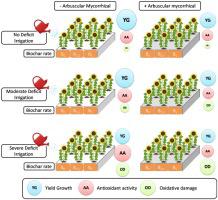Field Crops Research ( IF 5.6 ) Pub Date : 2021-09-17 , DOI: 10.1016/j.fcr.2021.108292 Ali Reza Safahani Langeroodi 1 , Roberto Mancinelli 2 , Emanuele Radicetti 3

|
Arbuscular mycorrhizal (AM) fungi and biochar have been successfully adopted to improve crop growth and yield under water stressed environments, however, to date little evidence of their combined effects has been reported. Field trials were conducted in 2018 and 2019 growing seasons in northern Iran to evaluate how biochar and AM fungi could improve sunflower (Helianthus annuus L.) productivity subjected to reduced irrigation regimes. A randomized complete block design was adopted with the following treatments: three irrigation regimes [no deficit irrigation (NDI), moderate deficit irrigation (MDI) and severe deficit irrigation (SDI) that was calculated as the 50, 30, and 10 % of maximum available water, respectively]; three biochar rates [0 (B0), 2.5 (B2.5) and 5 (B5) t ha−1 of biochar]; and two AM fungi inoculations [inoculated (AM+) and no-inoculated (AM-) plants]. All treatments were replicated three times. Before plowing, biochar (B2.5 and B5) was uniformly distributed on the soil surface to incorporate in the soil profile, while AM fungi (AM+) were distributed in the furrow of sunflower rows before sowing. Biochar and AM fungi were not applied in B0 and AM- treatments, respectively. Sunflower growth rate, pigments, photosynthesis rate and associated aspects, minerals content, antioxidant enzymes, abscisic acid, total phenolics and seed yield were measured. The results showed that growth parameters, radiation use efficiency, leaf pigments and seed yield decreased under irrigation regimes (NDI > MDI > SDI), while malondialdehyde (MDA) and hydrogen peroxide (H2O2) showed opposite trends. The combination AM fungi and biochar enhanced antioxidant enzymes activities, osmoprotectants, nutrient content and relative water content resulting in a significant decrease in oxidative damage in the drought stressed plants. Seed yield ranged from 4.95 to 1.78 t ha−1 and it was increased by the biochar application (+9% and +7% in B2.5 and B5, respectively) and AM fungi inoculation (+21 % in AM+) in all irrigation regimes. Overall, the plant's performance observed in the MDI-B5-AM+ was similar to that in NDI-B0-AM- indicating that AM fungi and biochar allow a reduction of water irrigation while maintaining crop yield. According to results, the combination of AM fungi and biochar rate should be adopted as a water-saving practice for sustainable production of sunflower cultivated in semi-arid environments, even if further studies should be carried out to evaluate their effects on other crops and environments.
中文翻译:

生物炭和丛枝菌根真菌对半干旱环境下向日葵可持续栽培的贡献
丛枝菌根 (AM) 真菌和生物炭已成功用于改善水分胁迫环境下的作物生长和产量,然而,迄今为止,关于它们联合作用的证据很少。在伊朗北部 2018 年和 2019 年的生长季节进行了田间试验,以评估生物炭和 AM 真菌如何在减少灌溉制度的情况下提高向日葵 ( Helianthus annuus L.) 的生产力。采用以下处理的随机完整区组设计:三种灌溉制度[无亏缺灌溉 (NDI)、中度亏缺灌溉 (MDI) 和严重亏缺灌溉 (SDI),计算为最大灌溉量的 50%、30% 和 10%可用水,分别]; 三个 biochar 比率 [0 (B 0 ), 2.5 (B 2.5) 和 5 (B 5 ) t ha -1的生物炭];和两种 AM 真菌接种 [接种 (AM + ) 和未接种 (AM-) 植物]。所有处理均设 3 次重复。耕作前,生物炭(B 2.5和B 5)均匀分布在土壤表面以融入土壤剖面,而AM真菌(AM +)在播种前分布在向日葵行的犁沟中。B 0中未使用生物炭和 AM 真菌和 AM- 治疗,分别。测量了向日葵的生长速率、色素、光合作用速率和相关方面、矿物质含量、抗氧化酶、脱落酸、总酚和种子产量。结果表明,灌溉制度(NDI > MDI > SDI)下生长参数、辐射利用效率、叶色素和种子产量下降,而丙二醛(MDA)和过氧化氢(H 2 O 2)则呈相反趋势。AM 真菌和生物炭的组合增强了抗氧化酶活性、渗透保护剂、营养成分和相对含水量,从而显着减少了干旱胁迫植物的氧化损伤。种子产量从 4.95 到 1.78 吨公顷-1在所有灌溉制度中,生物炭应用(分别在 B 2.5和 B 5 中+9% 和 +7% )和 AM 真菌接种(在 AM + 中 + 21% )都增加了。总体而言,在 MDI-B 5 -AM + 中观察到的植物性能与在 NDI-B 0 -AM- 中观察到的性能相似,表明 AM 真菌和生物炭允许减少灌溉用水,同时保持作物产量。根据结果,即使需要进一步研究以评估它们对其他作物和环境的影响,也应采用 AM 真菌和生物炭率相结合作为在半干旱环境中可持续生产向日葵的节水措施.











































 京公网安备 11010802027423号
京公网安备 11010802027423号